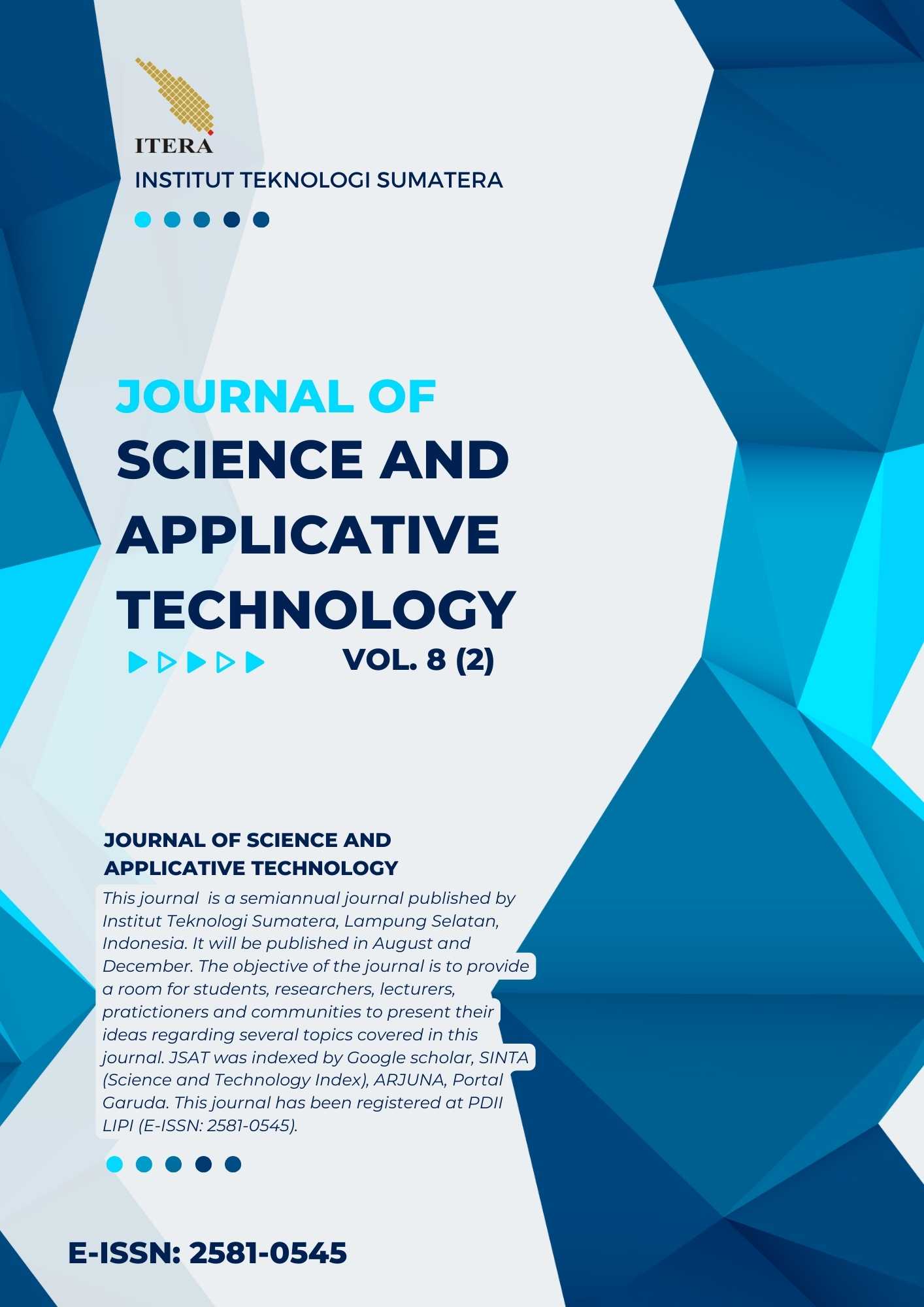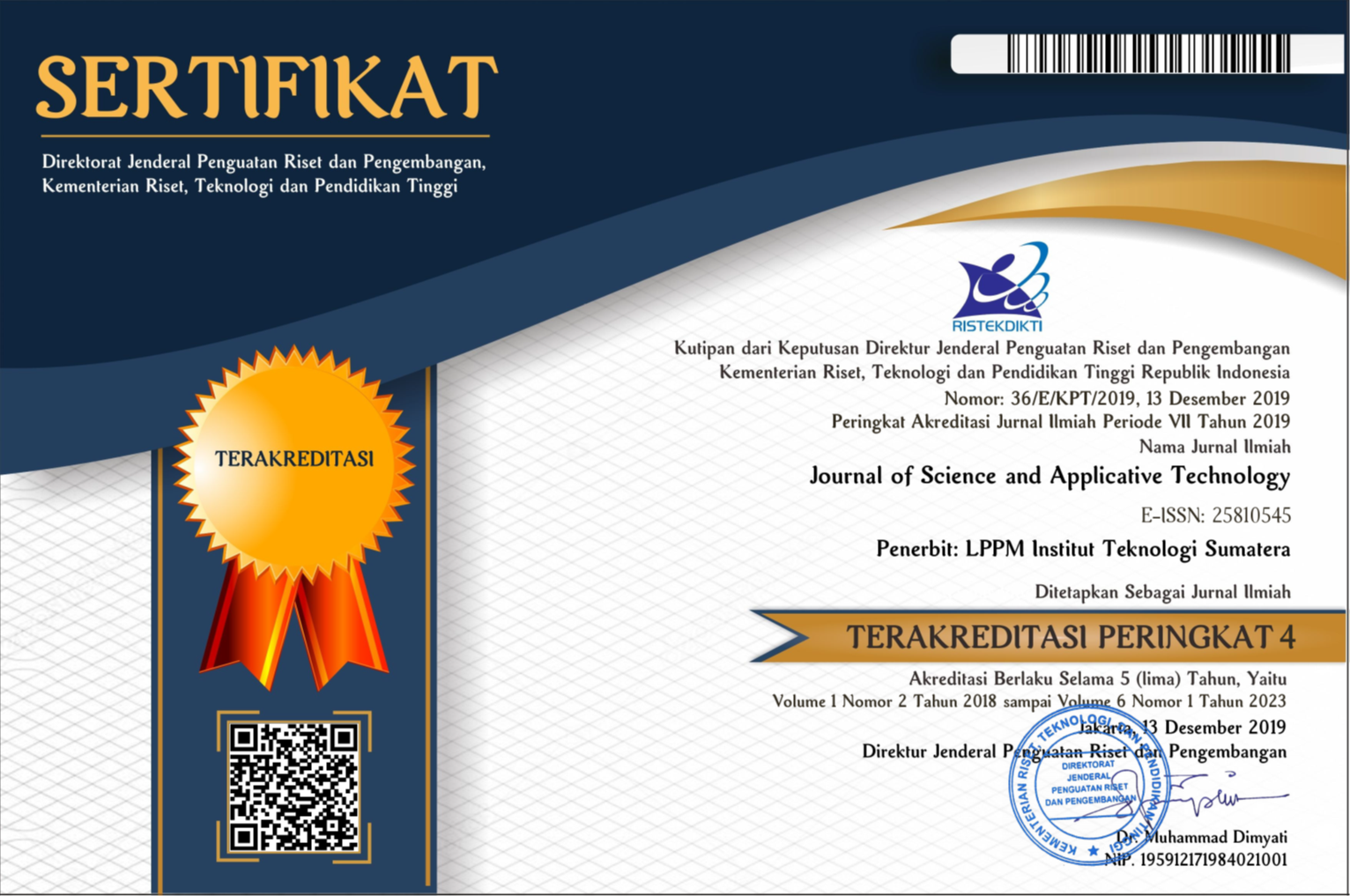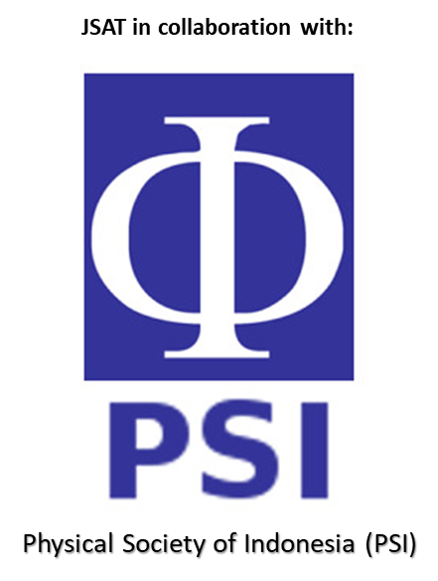Identifikasi Perambatan Gelombang Kelvin pada Fluktuasi Parameter Atmosfer di Wilayah Padang, Jakarta dan Pontianak Menggunakan Data Radiosonde dan GNSS-RO
Abstract
Analisis pergerakan gelombang Kelvin pada fluktuasi parameter atmosfer dilakukan dengan memanfaatkan data pengamatan vertikal atmosfer dari radiosonde dan GNSS-RO. Metode filtering dengan penerapan Fast Fourier Transform (FFT) digunakan untuk mengidentifikasi arah dan fluktuasi perambatan gelombang temperatur di lapisan troposfer atas hingga stratosfer bawah. Hasil plot deret waktu parameter atmosfer menunjukkan bahwa fluktuasi temperatur dan komponen angin zonal memiliki perambatan yang identik dengan gelombang Kelvin. Perambatan temperatur dan angin zonal berpropagasi ke arah timur dengan skala waktu 7-10 harian serta 10-20 harian. Temperatur berfluktuasi dengan interval nilai –4 sampai 4 K untuk data radiosonde dan –3 hingga 3 K untuk data GNSS-RO. Fluktuasi komponen angin zonal berkisar pada rentang –30 hingga 10 m.s-1.
Downloads
References
[2] H. A. rahman, “Global Climate Change and Its Effect on Human Habitat and Environment in Malaysia,” Malaysian Journal of Environmental Management, vol. 10, pp. 17-32, Jan. 2009.
[3] R. Syafina, Dasep, and Noersomadi, “Pemodelan Perambatan Gelombang Mixed Rossby-Gravity di Lapisan Stratosfer Bawag Menggunakan Algoritma Linier Gauss-Newton,” Jurnal EurekaMatika, vol. 10, pp. 79-92, Des. 2022.
[4] M. C. Wheeler, “Tropical Meteorology Equatorial waves,” Encyclopedia op Atmospheric Sciences, Second Edittion, vol. 6, pp. 102-112, Feb. 2015.
[5] N. Cornelius A, “Identifikasi Gelombang Kelvin di Lapisan Tropopause Indonesia Bagian Barat dengan Menggunakan Data Sounding NOAA,” Jurnal Sains & Teknologi Modivikasi Cuaca, vol 11. Pp. 19-27, Jun. 2010.
[6] J. R. Holton, An Introduction to Dynamic Meteorology Fourth Edition. Elsevier Academic Press, 2004.
[7] T. Matsuno, “ Quasi-geostropic Motion in the Equatorial Area,” J. Meteorol. Soc. Jpn, Vol. 4. Pp 25-42, Feb. 1966.
[8] S. W. Lubis, S. Setiawan, “Identifikasi Gelombang Kelvin Atmosfer Ekuatorial di Indonesia Berbasis Data NCEP/NCAR Reanalysis I,” Jurnal Fisika Himpunan Fisika Indonesia, vol. 10, pp.71-82, Dec. 2010.
[9] N. Ambarsari, E. Yulihastini, “ Pengaruh Osilasi Tahunan dan ENSO terhadap variabilitas ozon total Indonesia,” Jurnal Teknologi Indonesia, vo. 34, pp. 90-97, 2011.
[10] S. Maharani, H. A, Rejeki, “Pengaruh Propagasi Madden Julian Oscillation (MJO) di Benua Maritim Indonesia (BMI) Terhadap Siklus Diurnal Dinamika Atmosfer dan Cuaca Hujan di Provinsi Lampung Tahun 2018,” Jurnal Sains & Teknologi Modifikasi Cuaca, vol. 22, pp. 71-84, Dec. 2021.
[11] P. Setiawan, dkk, “Estimasi Air Mampu Curah Menggunakan Data Modis Sebagai Informasi Spasial di Pulau Jawa,” Jurnal Penginderaan Jauh, vol. 3, pp. 64-76, Jun. 2006.
[12] C. Shu-Ya, dkk, “An Impact Study FNSS RO on the Prediction of Typhoon Nepartak (2016) Using a Multiresolution Global Model with 3D-Hybrid Data Assimilation,” American Meteorological Society Journals, vol. 36, pp. 957-977, Jun. 2021.
[13] D. T. Kusuma, Fast Fourier Transform (FFT) Dalam Transformasi Sinyal Frekuensi Suara Sebagai Upaya Perolehan Average Energy (AE) Musik,” Jurnal Pengkajian dan Penerapan Teknik Informatia, vol. 14, pp. 28-35, Oct. 2020.
[14] A. Y. Pratama, dkk, “ Noise Handling pada Sinyal Seismik Menggunakan Fourier Transform,” E-Proceeding of Engineering, vo. 7, pp. 4699-4710, Agustus 2020.
[15] D. F. Andarini, Noersomadi, “Deteksi Pengaruh Gelombang Kelvin pada Fluktuasi Uap Air di Tropopause Menggunakan Model Inversi,” Majalah Geografi Indonesia, vol. 34, pp. 63-71, Mar. 2020.
[16] G. Y. Yang, B. J. Hoskins, J. M. Slingo, “Equatorial Waves in Opposite QBO Phase,” Journal of the Atmospheric Sciences, vo. 66, pp. 839-862, April 2011.
[17] G. N. Kiladis, M. C. Wheeler, P. T. Haertel, K. H. Straub & P. E. Roundy, “Convectively coupled equatorial waves,” Reviews of Geophysics, vol. 47, pp. 1-42, April 2009.
[18] F. R. Muhammad, C. Vincent , A. King & S. W. Lubis, “The Impacts of Convectively Coupled Equatorial Waves on Extreme Rainfall in Northern Australia,” American Meteorological Society Journals of Climate, Aug. 2024.
[19] E. Yigit, & A. S. Medvedev, “Internal wave coupling processes in Eart’s atmosphere,” Advances in Space Rerearch, vol. 55, pp. 983-1003, Fe. 2015.
[20] J. M. Wallace, and V. Kousky, “Observational evidence of Kelvin waves in the tropical stratosphere,” J. Atmos. Sci., vol. 25, pp. 900-907, 1968.
[21] A. A. Shabaan, & P. E. Roundy, “Upward and downward atmospheric Kelvin waves over the Indian Ocean,” Quarterly Journal of the Royal Meteorological Society, vol. 147, pp. 3154-3179, Jul. 2021.
[22] W. J. Randel, and F. Wu, “Kelvin wave variability near the equatorial tropopause obserberd in GPS radio occultation measurments,” Journal of Geophysical Research, vol. 110, Feb. 2005.
[23] D. Takasuka, & S. Yokoi, “Observational Evidence of Mixed RossbyGravity Waves as a Driving Force for the MJO Convective Initiation and Propagation,” Geophysical Research Letters, vol. 46, May 2019.
[24] M. Ern, and P. Preusse, “Wave fluxes of equatorial Kelvin waves and QBO zonal wind forcing deriverd from SABER and ECMWF temperature space-time spectra,” Atmospheric Chemistry and Physics, vol. 12, pp. 3957-3986, Jun. 2019.
Copyright (c) 2024 Journal of Science and Applicative Technology

This work is licensed under a Creative Commons Attribution-NonCommercial 4.0 International License.
All the content on Journal of Science and Applicative Technology (JSAT) may be used under the terms of the Creative Commons Attribution-NonCommercial 4.0 International License.
You are free to:
- Share - copy and redistribute the material in any medium or format
- Adapt - remix, transform, and build upon the material
Under the following terms:
- Attribution - You must give appropriate credit, provide a link to the license, and indicate if changes were made. You may do so in any reasonable manner, but not in any way that suggests the licensor endorses you or your use.
- NonCommercial - You may not use the material for commercial purposes.
- No additional restrictions - You may not apply legal terms or technological measures that legally restrict others from doing anything the license permits.





















